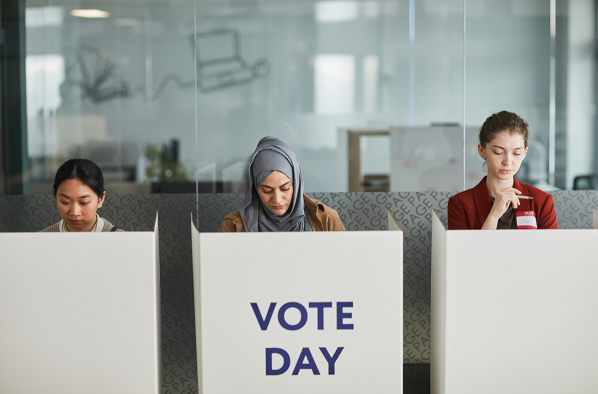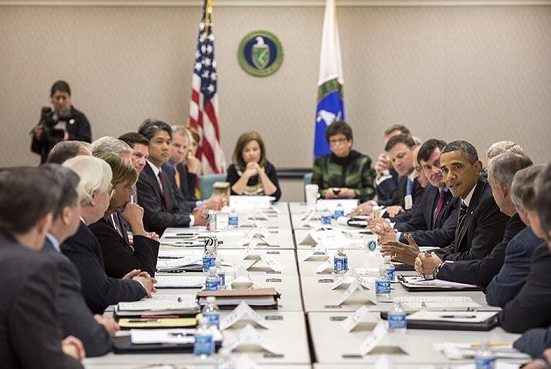What’s motivating women to vote?

By Selen Ozturk
Abuse in office
This violence is a pervasive threat for those on the ballots — and a national Brennan Center for Justice report found that abuse of local elected officials and election workers disproportionately impacts women.
Among over 350 state legislators surveyed, over 40% had experienced threats or attacks in the past several years, while nearly 20% of local officeholders had. Furthermore, 8% of state legislators said they were explicitly intimidated by a member of the public carrying a weapon — which is allowed in legislative chambers in many states.
“When you take into account less severe forms of abuse, like harassment, assaults, and stalking, almost 90% of state legislators and over half of local officeholders had experienced some form of abuse,” said Maya Kornberg, research fellow on the Elections and Government Program at the Brennan Center at a Friday, March 8 Ethnic Media Services briefing on issues guiding women at the polls.
Women and people of color not only experienced more abuse than their male and white counterparts, but different kinds.
“They were likely to tell us that they were subjected to identity-based abusive language about their children and their families, romantic life, appearance, age, race or gender,” continued Kornberg. “Women serving in state legislatures were nearly four times as likely as men to experience abuse of a sexual nature.”
“This is not only a threat to the safety of our officeholders, but also to our democracy,” she said. Some 40% of local and 20% of state officeholders said this abuse made them “more reluctant to engage with their constituents, either online or in public … Half of women in local office said it was deterring them from running for reelection.”
Reproductive rights
Another issue ever-more urgent to women’s concerns is reproductive rights, especially since the 2022 Dobbs v. Jackson decision overturned Roe v. Wade and eliminated the constitutional right to abortion.
“Reproductive justice includes the human right to have the children that we want; raise our children in safe communities; to be able to prevent or have pregnancies without shame and with dignity; and our human right to make our own decisions about our bodies, our families and our futures,” said Monica Simpson, executive director at Sister Song, a network recognizing the reproductive rights of marginalized communities.
Increasing U.S. abortion bans after the Dobbs decision have worsened “a maternal health crisis in this country,” she continued. “Even having the legal right to something does not grant access. Before Dobbs, we had areas or states like Mississippi that only had one abortion clinic, and the Hyde Amendment” banning federal funding through Medicaid to cover almost all abortions.
In the first half of 2023, nearly one in five patients were traveling out of state for abortion care, compared with one in 10 in 2020.
“This is a crisis worsened by additional barriers like contraception deserts, inequitable access to sex education, law enforcement brutality, and preventing Medicaid expansion in states with abortion bans,” said Simpson.
Domestic work
“In the U.S. every day, 10,000 children are born and approximately 10,000 people turn 65. We’re living longer than ever before, and so we need more care than ever,” said Ai-Jen Poo, president of the National Domestic Workers Alliance. “Yet, we don’t have a national affordable child care program, a federal paid family and medical leave program or a long-term care benefit.”
“What we have is 53 million overstretched family caregivers who are mostly women, and over 7 million care workers who are underpaid and are overwhelmingly women — about 90% women, and mostly women of color,” she continued.
The median annual income for a U.S. homecare worker is $23,000 per year.
“It’s hard to picture supporting yourself and raising a family in this country on poverty wages without benefits, health insurance, child care and paid time off, which is why expanded care access is so urgent,” Poo said. “The 11 million women in the U.S. who are in the generation sandwiched between caring for young children and caring for aging parents are especially feeling the brunt of this.”
Gun control
The national epidemic of gun violence, too, is motivating women to vote for a safer future.
“In America, there’s a gun for every man, woman, child and dog. There are more guns than people and more gun dealers than all Starbucks and McDonald’s combined,” said Shikha Hamilton, vice president of Organizing at Brady which tackles the issue of gun violence . “It’s not a mental health or domestic violence issue. The problem is easy access.”
In 2000, Brady first held a Million Mom March — the largest gun protest at the National Mall in U.S. history at the time, with over 750,000 people there and thousands more nationwide in 78 cities calling for an end to gun violence.
The impact was nearly immediate, said Hamilton: “Stalled gun safety legislation sailed through state houses that November including a referendum to close the gun show loophole, organizers led thousands on another march to the polls, and NRA stalwarts were voted out of Congress in 2000 in two states.”
“Our calls for change more recently have led to the passage of the bipartisan Safer Communities Act and the creation of the nation’s first-ever White House Office of Gun Violence Prevention — which was led by a woman, Vice President Kamala Harris,” she continued. Despite partisan rhetoric, this issue “unites women across the aisle.”
About 90% of all Americans in 2019, for instance, supported background checks on all gun sales. A historical record 48,830 gun deaths in 2021 reflected a 23% rise since then, while gun deaths among children and teens rose 50% in those two years — from 1,732 in 2019 to 2,590 in 2021.
“Women continue to lead this movement because we’re horrified to see what this epidemic is doing to us and our children,” Hamilton added. “Women from all walks of life will continue to fight this epidemic until we have created a safer future for the next generation by freeing America from gun violence.” – Ethnic Media Services













